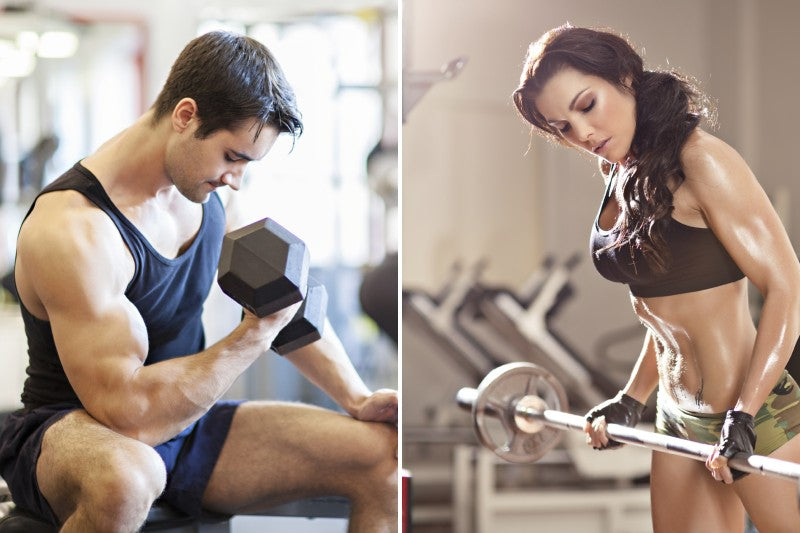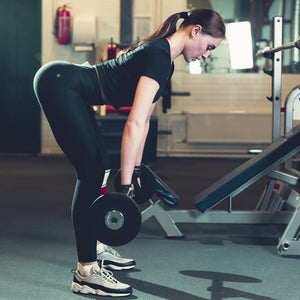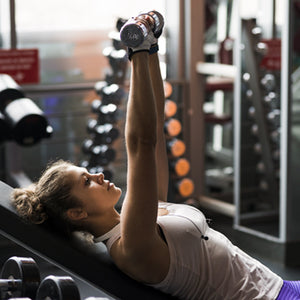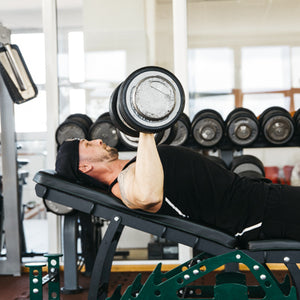
Which is Better? Compound or Isolation Exercises
The world of fitness and nutrition is filled with all sorts of myths, legends, and broscience which obscure the distinction between truth and fiction. From not eating carbohydrates after 6 PM to squats are bad for your knees, the magnitude and scope of discrepancies between perception and reality are staggering.
One of the most common ones you’ll hear is that you only need to perform compound exercises in order to build muscle and increase strength, and that isolation exercises are a waste of time.
Related - 6 Compound Exercises You Should Never Swap Out
But is this definitively true, or is this just one of the many myths promoted by the mad “functional” training enthusiasts? Are those flies, curls, and kickbacks a complete and utter waste or are they serving some purpose aside creating a pump and inflating your ego?
What’s the truth? Let’s find out!
What are Compound Exercises?
Compound exercises are exercises that work multiple joints and muscle groups. Common examples of compound exercises are:
- Squats
- Lunges
- Chest Presses
- Shoulder Presses
- Pull-ups
- Deadlifts
- Rows
Each of these movements involve more than one muscle group. For example, the squat involves the quads, hamstrings, glutes, and to a lesser degree, the entire upper body (it has to support or hold the weight you are squatting). These movements are foundational movements you do throughout your daily life and essentially involve you pushing, pulling, or squatting some load against gravity.
Benefits of compound exercises:
- Improve movement efficiency
- Burn more calories
- Enhance intermuscular coordination
- Elevate heart rate (improving cardiovascular training)
- Move heavier weight compared to isolation exercises
- Involve multiple muscle groups
- Act as a form of dynamic stretching
Since these movements are so essential to everyday life, and the fact that they recruit so many different muscles, it stands to reason that they would be effective for building muscle and strength.
But does that mean that compound exercises are the only thing you should be performing? We’ll answer that in a bit, but first, let’s discuss the other end of the spectrum - isolation exercises.

What are Isolation Exercises?
Isolation exercises are those exercises that target a single muscle group. Common examples of isolation exercises are:
- Bicep curls
- Tricep kickbacks
- Calf raises
- Pec dec
- Lateral raises
- Leg extensions
- Leg curls
Benefits of isolation exercises:
Isolation exercises are beneficial for specifically targeting (“isolating”) a specific muscle group (biceps, triceps, quads, etc.).
It’s commonly thought that the only people interested in isolation lifts, or the only population they benefit, are bodybuilders. While it’s true that isolation lifts certainly are useful for those looking to refine their physique to the nth degree, that’s not the only purpose isolation exercises serve. There are actually several reasons you’d want to use isolation exercises from time to time.
First off, they ideal for rehabilitating an injury. If you’ve torn a hamstring or sprained your knee, it’s less than ideal (and risking further injury) if you go and try to pull off a max rep on back squats or deadlifts. However, performing isolation exercises like leg curls, glute bridges, Russian leg curls (Nordic hamstring exercise), etc. allow you to strengthen the weakened areas of the lower body without overly straining the injured areas.
Second, isolation exercises can help to even out muscle imbalances, relative to size or strength, or bring up “weak points.”
For example, the bench press involves the chest, shoulders, and triceps. While you may have very strong chest and shoulder muscles, if your triceps are weak, you’ll have trouble finishing the lift.
This is because the chest and shoulders perform the majority of the work in driving the bar off the chest, but it’s the triceps that finish or “lock out” the lift. Weak triceps can leave you just finishing your rep, and ultimately short of reaching your goals.
This is why you’ll see even elite powerlifters incorporate some isolation work into their training programs - to help shore up any weaknesses in the secondary muscles which could be limiting their overall strength output.
Now, some in the compound-only crowd will argue and say that isolation exercises actually lead to muscle imbalances, not correct them.
While it’s true that if you only performed one type of isolation exercise in your training program (for example: front raises), you would develop imbalances (in the other areas of the shoulder, leading to the hunched over or “pulled forward” look). The flip side is also true that if you only did bench press in your workouts, you would end up in the same situation, and never address what’s really restricting your progress in the lift.
You see, no matter how proficient or advanced we are with weightlifting or bodybuilding, each of us is dominant in some way or another one every lift and has certain tendencies when performing a lift. For example, some people may recruit more of their hamstrings than their quadriceps when performing a squat, while another person is the exact opposite. Or, when performing a pull-up, you might pull more with one side of your back or another.
In this scenario, if you’re only performing compound lifts you can develop imbalances, and failing to address these weak points or imbalances will limit your performance and possibly lead to injury.
While these reasons all sound very logical and make good sense, is any of it backed by research, and what about the original question, are compound exercises clearly superior to isolation exercises for improving size and strength?
Compound vs Isolation Research
To begin to answer the question of compound vs isolation exercises for better gains, let’s start things off with a new study that compared the Nordic Hamstring Exercise (a.k.a. Russian Leg Curl) vs the stiff-leg deadlift on regional hamstring recruitment. [1]
Researchers had 12 male athletes with no prior hamstring injuries perform the exercises and recorded the activity of the biceps femoris long head and semitendinosus. Following the testing period, the team noted that when performing the Russian Leg Curl, overall semitendinosus activity was significantly higher than that of the biceps femoris long head, while there were only trivial differences between the two muscles when performing the stiff-leg deadlift.
To further compound the matter, researchers also documented regional differences (proximal vs distal) in the muscles when the men performed the Russian leg curl. The distal region (area further away from your glutes) of the semitendinosus had the lowest activity level but the highest activity in the biceps femoris. When performing the stiff-leg deadlift, there were only minimal differences between the regional activation of the muscles.
So, based on this, a compound enthusiast will say, “see, all you need is stiff-leg deadlifts to work the hamstrings properly, since Russian Leg Curl don’t work the muscles evenly.” A physique competitor will look at these results and say, “great, this can help me to bring up those lagging portions of my hammies.”
The truth is, this study doesn’t tell us one way or another that compound movements are superior or that isolation movements are good or bad, conclusively. This study just notes differences in recruitment of your hamstrings when performing two different exercises. Furthermore, you cannot extrapolate the results from this one exercise and apply it to an entire program of only compound or isolation movements.
In the end, this particular study merely gives us data on how these exercises target a group of muscles. Lucky for you, there was a recent study conducted comparing compound only training to isolation only training!
A 2017 study involving 36 soccer players looking to make gains followed either a compound only or isolation only training program for 8 weeks. [2] Work was equated between the two groups. Both trained to failure with 4 sets of each prescribed exercise. However, the isolation exercise group performed sets of 12-18 reps with 1.5-2 minutes rest while the compound group performed sets of 6-8 reps with 2.5-3 minutes rest.
The aim of the study was to simulate practical training settings and equate total volume of work between the two training methods. At the end of the 8 weeks, researchers noted:
“In conclusion, when total work volume was equated, RT (resistance training) programs involving MJ (multi-joint) exercises appear to be more efficient for improving muscle strength and maximal oxygen consumption than programs involving SJ (single-joint) exercises, but no differences were found for body composition.”
So, data showed that in terms of overall body composition, isolation exercises can be just as effective as compound exercises for improving body composition. However, compound exercises are better for improving strength and endurance, which does make sense, but it also brings up a good question.
If the isolation group performed their exercises in the 6-8 rep range and rested the same length as the compound group (2.5-3 minutes), would they have experienced similar increases in strength and endurance?
We have no way of conclusively knowing, which is one of the limitations of this study. FYI, all studies have limitations, it’s just a fact of science.
So, what’s the verdict? Do you only need compound exercises?
The Verdict
Do both.
Performing only compound or isolation exercises set you up for possible weak points and imbalances that ultimately limit your performance and physique goals. The best approach is to use a mix of methods as compound exercises and isolation exercises form a symbiotic relationship where each serves to strengthen the other, ultimately translating to better results for you!
References
1) Hegyi A, Peter A, Finni T, Cronin NJ. Region-dependent hamstrings activity in Nordic hamstring exercise and stiff-leg deadlift defined with high-density electromyography. Scand J Med Sci Sports. 2018;28(3):992-1000. doi:10.1111/sms.13016.2) Paoli A, Gentil P, Moro T, Marcolin G, Bianco A. Resistance Training with Single vs. Multi-joint Exercises at Equal Total Load Volume: Effects on Body Composition, Cardiorespiratory Fitness, and Muscle Strength . Front Physiol . 2017;8:1105. https://www.frontiersin.org/article/10.3389/fphys.2017.01105.






